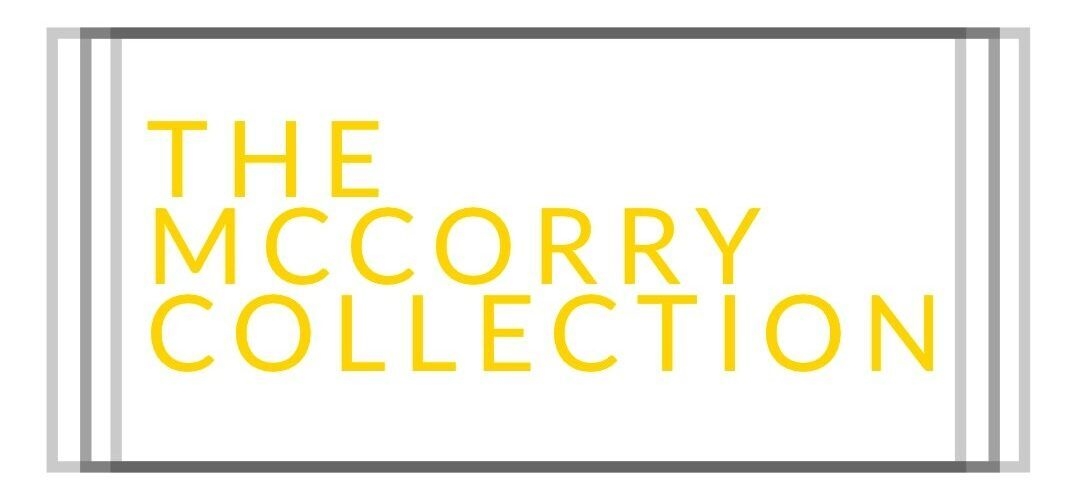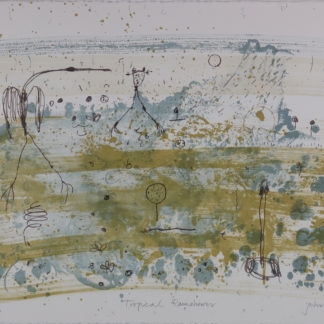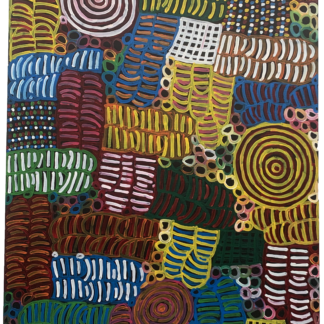Bio
Bio Judy Watson (Australian/Aboriginal 1959-)
Judy Watson was born in Mundubbera, Queensland in 1959. She is a Brisbane-based, Waanyi artist. She was educated at the Darling Downs Institute of Advanced Education Toowoomba, where she received a Diploma of Creative Arts in 1979; the University of Tasmania where she received a bachelor’s degree (1980–82); and Monash University where she completed a graduate diploma in 1986. At Tasmania she learned many techniques, among them lithography which has influenced her entire body of work.
Career
Watson trained as a print-maker and her work in painting, video and installation often relies upon the use of layers to create a sense of different realities co-existing. As an Indigenous artist, the depiction of the land has an ongoing significance in her practice.
She won the Moët & Chandon Fellowship in 1995, allowing her to travel to France and later exhibit there. She represented Australia at the Venice Biennale in 1997, along with Yvonne Koolmatrie and Emily Kame Kngwarreye.
In 2005, for French architect Jean Nouvel’s Musée du quai Branly she constructed a site-specific work for the building along with a number of other key Aboriginal artists. A film was made about the project, titled The French Connection.
Her work is often highly political, however it is rarely didactic. She describes her attitude to political art as follows:
“Art as a vehicle for invention and social change can be many things, it can be soft, hard, in-your-face confrontational, or subtle and discreet. I try and choose the latter approach for much of my work, a seductive beautiful exterior with a strong message like a deadly poison dart that insinuates itself into the consciousness of the viewer without them being aware of the package until it implodes and leaks its contents.”
She has been commissioned by the City of Sydney to create a major public work of art for their Eora Journey arts program. The sculpture, titled bara and expected to be in place by 2020, will be located at the Royal Botanic Gardens in Sydney. The installation consists of a representation of bara, or fish hooks made for thousands of years by women from the local Eora nation.
Themes
In the book on Watson’s work, blood language (2009) her practice is divided into a number of themes: water, skin, poison, dust and blood, ochre, bones, driftnet.[6] The list indicates the range of natural and cultural forms that underpin her practice.
Watson’s recent work can be understood as part of the archival turn in contemporary art. She examines Indigenous Australian histories. For example, a preponderance of aboriginal blood (2005) was commissioned by the State Library of Queensland to celebrate the Queensland centenary of women’s suffrage and forty years of Aboriginal suffrage. The work uses documents from the Queensland State Archives about the way Aboriginal people were precluded from voting. Before suffrage was granted in 1965, eligibility to vote was based on the percentage of Aboriginal blood, hence Watson’s title her series. The series was recently acquired by Tate Modern in London.
Other series that examine history and the archive include the holes in the land (2015). This series of six engravings is about the loss of Aboriginal cultural patrimony. In four of the six images Aboriginal cultural objects held in the British Museum are depicted. The title underscores the damage done to the land—the shadow, depression or blot on the landscape—removal has caused.

















